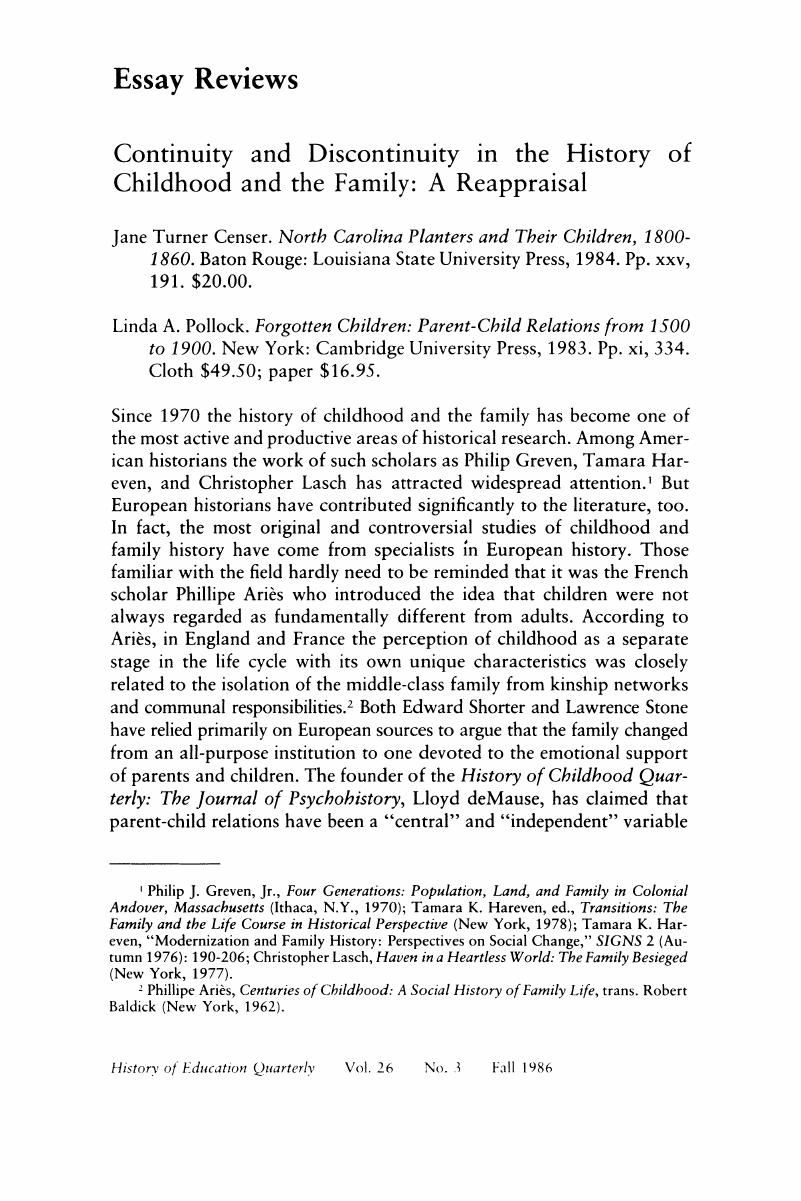Published online by Cambridge University Press: 24 February 2017

1. Greven, Philip J. Jr., Four Generations: Population, Land, and Family in Colonial Andover, Massachusetts (Ithaca, N.Y., 1970); Hareven, Tamara K., ed., Transitions: The Family and the Life Course in Historical Perspective (New York, 1978); Hareven, Tamara K., “Modernization and Family History: Perspectives on Social Change,” SIGNS 2 (Autumn 1976): 190-206; Lasch, Christopher, Haven in a Heartless World: The Family Besieged (New York, 1977).Google Scholar
2. Ariès, Phillipe, Centuries of Childhood: A Social History of Family Life, trans. Baldick, Robert (New York, 1962).Google Scholar
3. Shorter, Edward, The Making of the Modern Family (New York, 1975); Stone, Lawrence, The Family, Sex, and Marriage in England, 1500–1800 (London, 1977); deMause, Lloyd, ed., The History of Childhood (New York, 1974), 3.Google Scholar
4. Pollock, Linda A., Forgotten Children: Parent-Child Relations from 1500–1900 (New-York, 1983), 267.Google Scholar
5. See, for example, Hareven, , “Modernization and Family History,” 194–203; Shorter, , Making of the Modern Family, 54–56, 120–67, 205–54; Stone, , Family, Sex, and Marriage, 652–58.Google Scholar
6. Stone, , Family, Sex, and Marriage, 664, 657–58.Google Scholar
7. Hareven, , “Modernization and Family History,” 203.Google Scholar
8. Walsh, Lorena S., “‘Till Death Us Do Part’: Marriage and Family in Seventeenth-Century Maryland,” in The Chesapeake in the Seventeenth Century: Essays on Anglo-American Society & Politics, ed. Tate, Thad W. and Ammerman, David L. (Chapel Hill, N.C., 1979), 131–32; Darrett, B. and Rutman, Anita H., “‘Now-Wives and Sons-in-Law’: Parental Death in a Seventeenth-Century Virginia County,” in ibid., 157–61; Stone, , Family, Sex, and Marriage, 56–58; Censer, Jane Turner, North Carolina Planters and Their Children, 1800–1860 (Baton Rouge,' 1984), 22.Google Scholar
9. Censer, , North Carolina Planters. 113, 118.Google Scholar
10. Genovese, Eugene D., Roll, Jordan, Roll: The World the Slaves Made (New York, 1974), 3–7, 142, 450–58, 502–19.Google Scholar
11. Pollock, , Forgotten Children, 96.Google Scholar
12. Ibid., 97.Google Scholar
13. Ibid., 249.Google Scholar
14. Ariès, , Centuries of Childhood, 38; see also Stone, , Family, Sex, and Marriage, 651–52.Google Scholar
15. Ariès, , Centuries of Childhood, 128.Google Scholar
16. Pollock, , Forgotten Children, 55.Google Scholar
17. Ariès, , Centuries of Childhood, 47, 128, 133.Google Scholar
18. Stone, , Family, Sex, and Marriage, 669; deMause, , ed., History of Childhood, 5, 51–52; Pinchbeck, Ivy and Hewitt, Margaret, Children in English Society, 2 vols. (London, 1969).Google Scholar
19. Pollock, , Forgotten Children, 268, 271.Google Scholar
20. Ibid., 151.Google Scholar
21. Stone, , Family, Sex, and Marriage, 669.Google Scholar
22. Pollock, , Forgotten Children, 184.Google Scholar
23. In The Protestant Temperament: Patterns of Child-Rearing, Religious Experience, and the Self in Early America (New York, 1977), Philip Greven also shows what a creative historian can do to shed light on the history of childhood. Building on the diversity of colonial America, he uses religion and social standing to sort out and explain the different child-rearing styles adopted by American parents in the seventeenth and eighteenth centuries.Google Scholar
24. Pollock, , Forgotten Children, 88, 90. Italics hers.Google Scholar
25. Kaestle, Carl F., “The History of Literacy and the History of Readers,” Review of Research in Education, ed. Gordon, Edmund W., vol. 12 (Washington, D.C., 1985), 20–32; Pollock, , Forgotten Children, 73.Google Scholar
26. Glenn, Myra C., “School Discipline and Punishment in Antebellum America,” Journal of the Early Republic 1 (Winter 1981): 395–408. Although skeptical about the validity of parental advice literature as an indicator of family behavior, Pollock is willing to use newspapers, despite their well-deserved reputation for inaccuracies, to document child abuse in England between 1785 and 1860. Pollock, Forgotten Children, 91–95.CrossRefGoogle Scholar
Cutler, William W. III.Google Scholar
27. Elkind, David, The Hurried Child: Growing Up Too Fast, Too Soon (Reading, Mass., 1981); Winn, Marie, Children without Childhood (New York, 1983). In her book Winn exhibits a much greater historical awareness than most other writers on this subject, including Elkind.Google Scholar